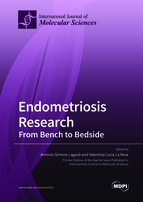Endometriosis Research: From Bench to Bedside
A special issue of International Journal of Molecular Sciences (ISSN 1422-0067). This special issue belongs to the section "Molecular Endocrinology and Metabolism".
Deadline for manuscript submissions: closed (20 December 2019) | Viewed by 62010
Special Issue Editors
Interests: women’s health; minimally invasive procedures; up-to-date management; gynecology; reproductive health; surgery
Special Issues, Collections and Topics in MDPI journals
Interests: developmental psychology; educational psychology; life cycle psychology; development in adolescence; attachment relationships; family; learning and quality of educational settings
Special Issues, Collections and Topics in MDPI journals
Special Issue Information
Dear Colleagues,
Endometriosis is defined as the presence of endometrial-like endometrial cells, glands, and stroma outside the uterus, causing a strong inflammatory-like microenvironment in the affected tissue. The exact prevalence of endometriosis is unknown, but estimates range from 2%–10% of women of reproductive age, to 50% of infertile women. Its etiopathogenesis of endometriosis still remains controversial—immune, hormonal, genetic, and epigenetic factors may be all involved, and several theories have been proposed to explain it.
This Special Collection aims to publish ground-breaking research that may open new scenarios and change the perspective of the topic. This concept will not be limited to clinical work about diagnosis, or pharmacologic and surgical treatments, but it will specifically involve basic science (immunology, cell biology, genetics, and epigenetics), to unravel new pathways to follow for the future diagnosis and management of endometriosis, and to improve our current knowledge of its etiology.
Dr. Antonio Simone Laganà
Guest Editor
Manuscript Submission Information
Manuscripts should be submitted online at www.mdpi.com by registering and logging in to this website. Once you are registered, click here to go to the submission form. Manuscripts can be submitted until the deadline. All submissions that pass pre-check are peer-reviewed. Accepted papers will be published continuously in the journal (as soon as accepted) and will be listed together on the special issue website. Research articles, review articles as well as short communications are invited. For planned papers, a title and short abstract (about 100 words) can be sent to the Editorial Office for announcement on this website.
Submitted manuscripts should not have been published previously, nor be under consideration for publication elsewhere (except conference proceedings papers). All manuscripts are thoroughly refereed through a single-blind peer-review process. A guide for authors and other relevant information for submission of manuscripts is available on the Instructions for Authors page. International Journal of Molecular Sciences is an international peer-reviewed open access semimonthly journal published by MDPI.
Please visit the Instructions for Authors page before submitting a manuscript. There is an Article Processing Charge (APC) for publication in this open access journal. For details about the APC please see here. Submitted papers should be well formatted and use good English. Authors may use MDPI's English editing service prior to publication or during author revisions.
Keywords
- Endometriosis
- Reproductive immunology
- Inflammation
- Cytokines
- Infertility
- In vitro fertilization
- Peritoneal fluid
- Apoptosis
- Epigenetics
- Minimally invasive surgery
- Ovary








